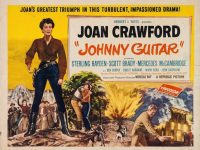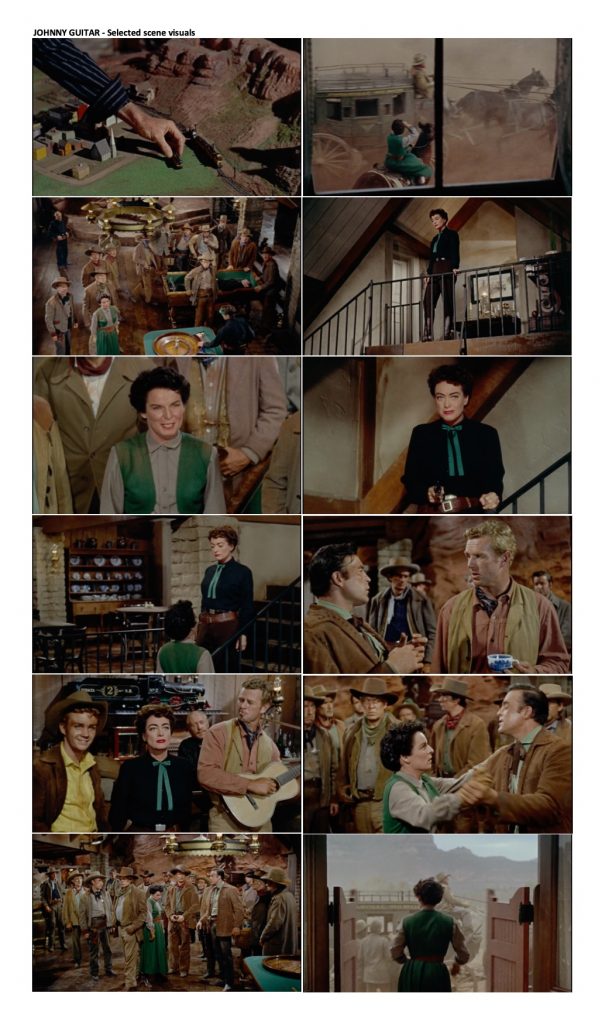Johnny Guitar

“Play the guitar, play it again, my Johnny
Maybe you’re cold but you’re so warm inside”
The beautiful words and the melody of Johnny Guitar have warmed our hearts for years. The song was made by Peggy Lee and Victor Young. Challenging the audience’s paradigm about western movies, the film was directed by the legendary Nicholas Ray and was released in 1954.
In the film, Vienna (Joan Crawford) opens a saloon in an area where the railway is planned to cross. However, it disturbs those who have power in the town, especially Emma (Mercedes McCambridge). Meanwhile, Johnny Guitar (Sterling Hayden), a former gunslinger and ex-lover of Vienna arrives to work at the saloon. When there is a stagecoach robbery that results in the death of Emma’s brother, she blames Vienna and Dancing Kid (Scott Brady), a regular of the saloon, and stirs up the town people to take revenge from them.
The film takes place in the West in the 19th century in the post-war era. In a way, it is a new phase of the American dream. It reflects the inevitable journey towards a modern society where the social system is well established and the rule of law is exercised. And where anybody has opportunities to change own life through entrepreneurship and smart investment. It creates anxiety for current rulers whose monopoly is at risk and who must change paradigms. The story is not tied to time and place as always in an ever-changing world.
In the 1950s, many women were dissatisfied with being limited to supporting men in motherhood and housewife roles. One may say that the (re)actions started in this period paved the way for feminist movement. The book The Second Sex, written by Simone de Beauvoir, was also translated into English in 1953. Although Johnny Guitar was set in a different period, the feminist approach in the story supports the move in the 1950s.
The paradigm of the audience is challenged both with the genre and the form of the film. It is referred to as a western, but we see a melodrama in which macho figures are second and female characters are at the forefront. The director chooses an exaggerated narrative style with its theatrical features, but it goes at the same time between the lines through the intense use of colour. The following year, in Rebel Without a Cause, Nicholas Ray further matures the use of colour in mise-en-scène.
Deniz Gezmiş, a pioneer of youth movements in Turkey, said his last request before being executed in 1972: I want to listen to Rodrigo’s guitar concerto. The sounds of the guitar resonated with the love in the heart of this fighting person. His spirit still guides many people. In the film Johnny Guitar, a similar guitar music softens the hearts of the tough temperament western man. In colourful scenes where reality and fairy tale coexist. It opens the doors of the cinema world, its potential furthermore. On the journey of love, hope and fighting for good…
The following is a review of the form of the film based on a selected scene. The selected scene photos can be seen below the article.
The film is rich in props. The guitar supports the melodrama texture of the film which was made in a western setting. Moreover, it takes the place of gun for Johnny to the extend that he changes his second name to Guitar, as a way to cut the links with his gunslinger past. The fix asset of western films, the gun is always in the scenes which is sometimes felt through its absence. Other strong elements are the saloon itself, the stagecoach and the main theme of the film, the train.
The set resembles a big opera stage. The chandelier, the paintings on the walls, the porcelain on the shelves represent the new bourgeois world Vienna wants to create for herself. The saloon leans against the rock that is visible from the inside, showing Vienna’s determination to stay there. The director strengthens the theatrical mise-en-scène with the use of expressionist colours. Warm lighting provides the vivid colours with depth.
The two women, Vienna and Emma, represent the tough characters. Both are fighting for their own ambitions and values. The men are no more tougher than what a typical western man would be. In general, they are in secondary positions. In the saloon, they work in Vienna’ service. In the town, they follow Emma’s directions. And the main male actors have rather soft and childish names: Johnny Guitar and Dancing Kid. The acting is tense and exaggerated as if on theatre stage, and they all stand as if they were in the frontline.
In the film, the men are in typical western clothes with guns. Vienna is masculine, dressed in a dark cowboy outfit. Her stylish hair and noticeable make-up draw attention. Her red lipstick reveals her sexy and passionate side despite her manly behaviour. Emma expresses her conservatism in gray but also looks ready to bloom with green. The saloon’s personnel are dressed in special costumes as if they work in a casino. This gives also an idea about Vienna’s vision of the saloon.
There is a physicological blocking on the way to Vienna’s floor. She reminds it with a gun in the middle of the stairs to everbody. Emma has to stop even before the stairs.
The camera stays static or pans during short distance move of the actors. A combination of different shots are utilized. Full shots visualize the crowd and the atmosphere of the saloon. Close-medium, medium and cowboy shots are used for interactions which are mostly emotional and hysterical. High/low angle shots put Vienna at higher position.
Vienna asks for the roulette running deliberately when the town people invade the saloon. Its sound indicates that the business is running despite their objections. When Vienna wants her message to be heard, she asks her staff to stop the roulette, showing also that she has the control. The saloon becomes suddenly deadly quiet. The mood changes for a while thanks to the joyful rhythm of Ol’ Joe Clark that Johnny plays for Dancing Kid to dance.
The film is edited in a classical way, especially during the dialogues. However, it is in general not seamless. When Emma leaves the saloon, for example, the editor does not allow spectators to see her last glance at Vienna.

